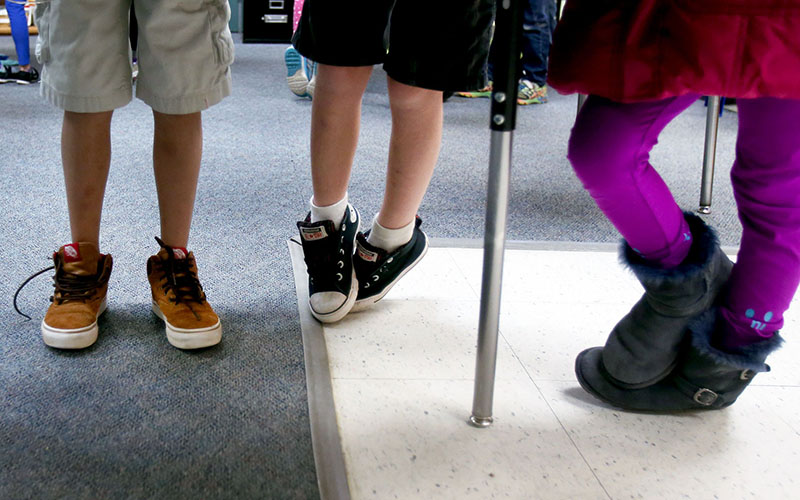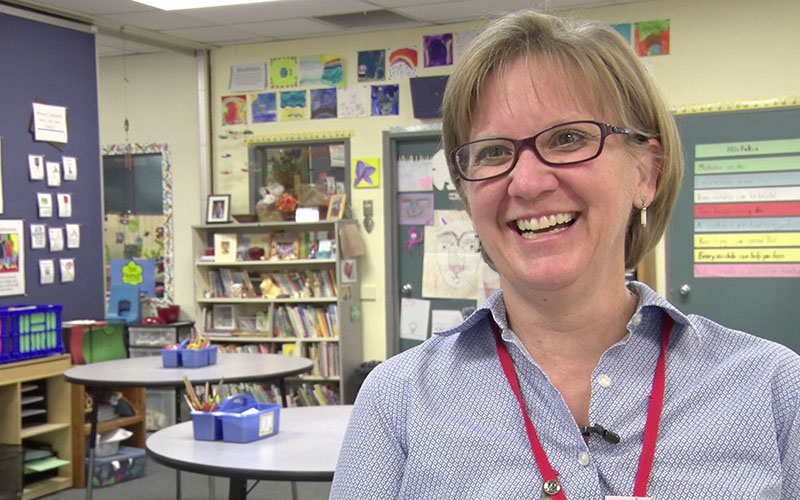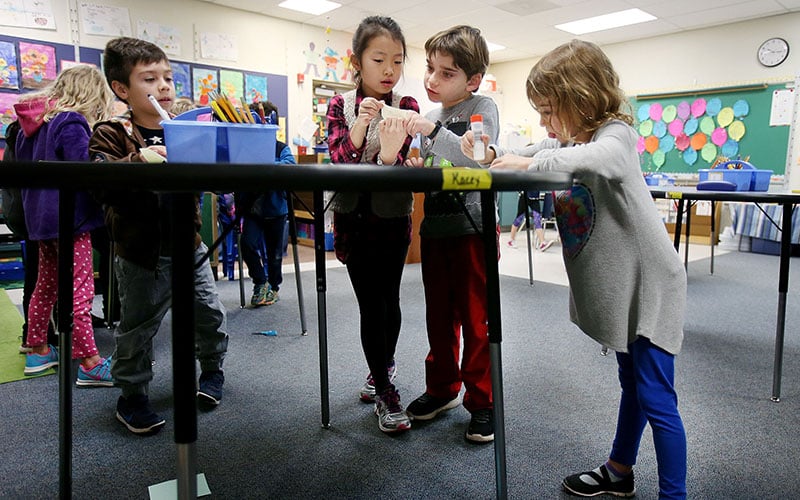
Students in Tiffany Wiley’s elementary class use standing desks to work on reading comprehension projects at Manzanita Elementary School in Tucson. (Photo courtesy of Mike Christy/Arizona Daily Star)
TUCSON – Four weeks ago, eight-year-old McKenzie Brown walked into her school, expecting to find the same classroom. Instead, the chairs were missing.
“I thought, ‘Did the teacher forget to put the chairs back in?’ ” the second-grader thought.
As it turns out, an experiment was the solution to the mystery of the missing chairs.

McKenzie Brown, a second-grader at Manzanita ElementarySchool in Tucson, likes using a standup desk. She says it keeps her from falling asleep in class. (Photo by Ivory Riner/Cronkite News).
Leaders at Manzanita Elementary School are trying out standing desks in one classroom, trying to discover if students are more productive and physically healthier.
Everything old is new again
Standing desks are a relatively new trend in modern America, moving from business offices to a few schools, including two in Tucson. But standing desks revive a centuries-old invention, according to advocates.
Standing desks were popular in homes of the wealthy during the 18th and 19th centuries. Notable men such as Thomas Jefferson, Benjamin Franklin and were known to use standing desks, sometimes called stand-up or adjustable-height desks. Now, they’re moving on to the nation’s students.
Tiffany Wiley, a first- and second-grade teacher at Manzanita, said the innovation started with a conversation with a parent of a student in her multi-grade classroom. The parent was affiliated with Stand Up Kids, an organization dedicated to putting stand-up desks in classrooms throughout America.
“It took me out of my comfort zone,” Wiley said of her initial approach to the idea of students standing, rather than sitting, as they did their work. She said she was concerned about how to maintain control in the classroom and how students would move around.

Tiffany Wiley, a first- and second-grade teacher at Manzanita Elementary School in Tucson, says parents and students like the school’s experiment with standup desks. (Photo by Ivory Riner/Cronkite News)
But after researching and making sure she understood how to manage the classroom, she decided to give standing desks a try in the new semester.
“So far it’s been successful and overwhelmingly positive,” Wiley said. “It’s more of a long-term approach, but I think it’s a better balance than what it used to be.”
Students used to work while sitting on the floor or on the chairs around the desks.
“Now, it’s sit on the floor, talk, read our stories, whatever we need to do instructionally, and then they go back and get a chance to take those ‘wiggle breaks’ while they’re working,” Wiley said.
Debating pluses, minuses of learning while standing
Standing desks have advantages and disadvantages, according to experts. People who are sedentary for most of their day are more prone to diabetes and metabolic problems, according to a 2008 study done by the U.S. National Library of Medicine and National Institutes of Health. Standing more during your day also reduces the risk of cancer, says a 2010 study from the same group.
Stand Up Kids said students who stand at desks burn more calories and reduce their body mass index, or BMI, according to its website. It helps to counteract the impact of kids sitting all day at school, in a car or bus, doing homework or eating.
However, a fitness website points out that although standing removes pressure from your shoulders and upper back, it adds pressure to your legs, feet and lower back, bringing unwanted soreness to different parts of your body.

Table mates (from left) Julian Hopkins, 6, Elise Kim, 7, Sawyer Lazarus, 8, and Lexi Appel, 7, work on their group project at a standing desk in Tiffany Wiley’s multi-grade elementary class at Manzanita Elementary School in Tucson. The school is experimenting with the idea of standing desks, implementing the change in January. (Photo courtesy of Mike Christy/Arizona Daily Star)© 2017 Arizona Daily Star
Students pleased with fewer chairs, more standing
“We know that kids today are much more sedentary than they have been in the past,” said Manzanita principal Kim Boling. “In large part this is perhaps due to the devices that they have, and we know that kids learn best when they are oxygenated in their brains. This is one opportunity to provide for that in a classroom.”
Wiley said there’s not a big difference in quality of work from the students after switching to stand-up desks, but “they’ve been more attentive and no one is super tired by the end of the day,” she said.
Wiley and her students have also talked about “respecting their bodies” by not crowding one another. Students who are feeling tired are allowed to sit in their “zone” at a standing desk or at a table with chairs in the back of the classroom.
Wiley surveyed students and some parents. Most liked the new desks, she said.
McKenzie, the student who was a little taken aback by the absence of chairs a few weeks ago, is a convert.
The desks “are healthier for you and when you’re standing you don’t fall asleep,” she said.